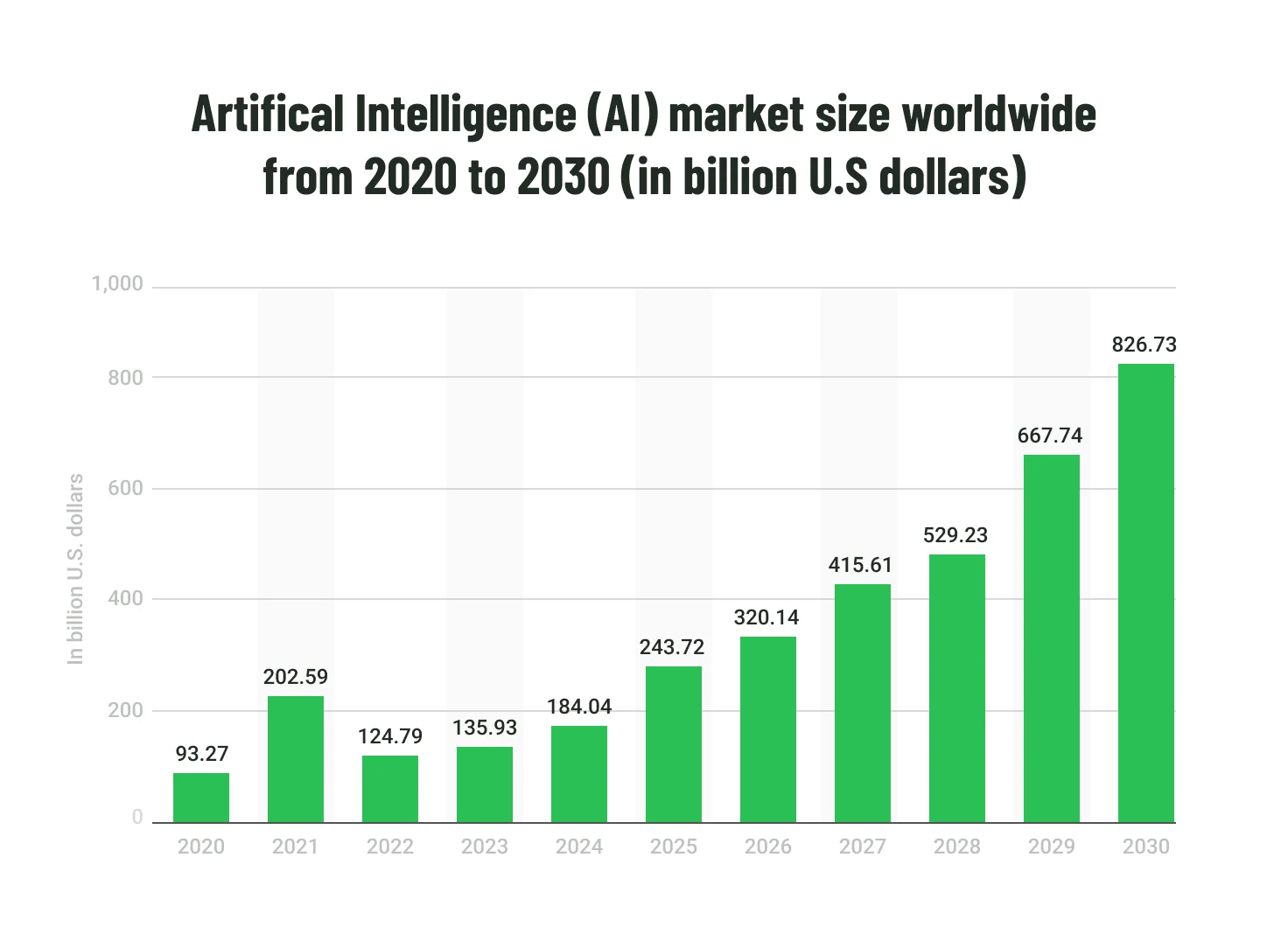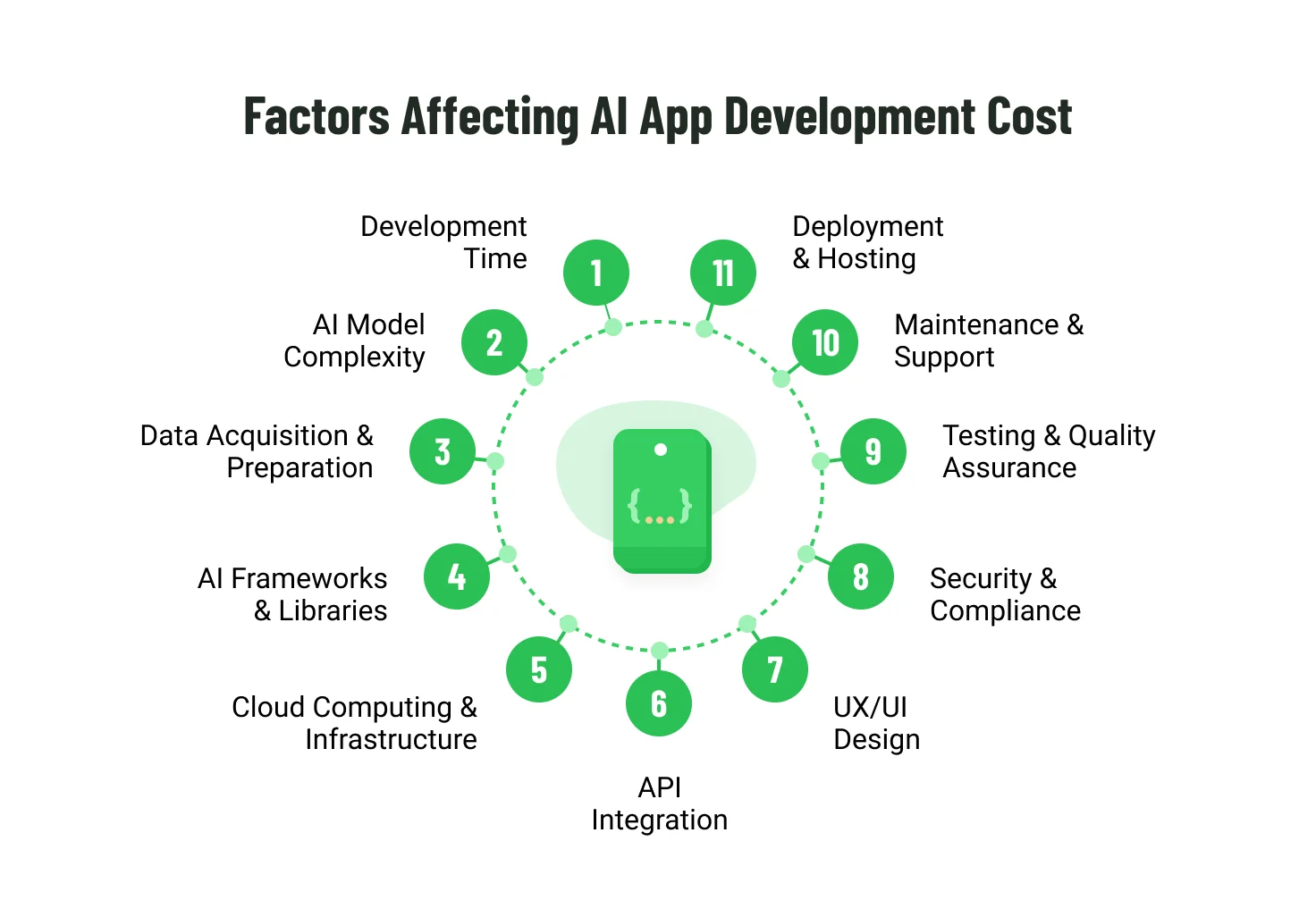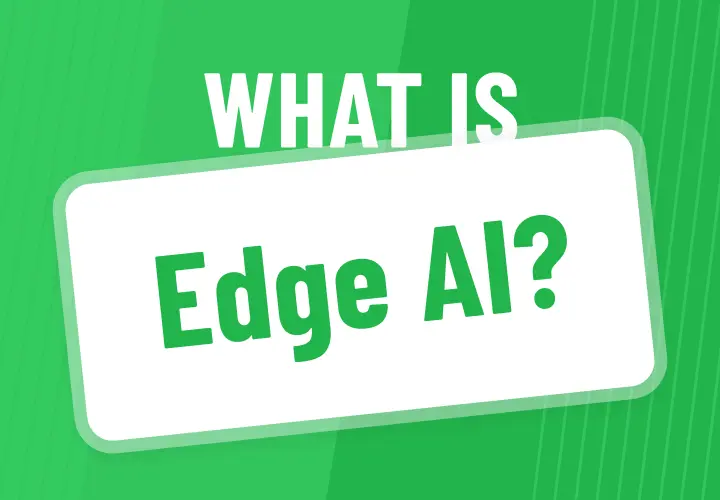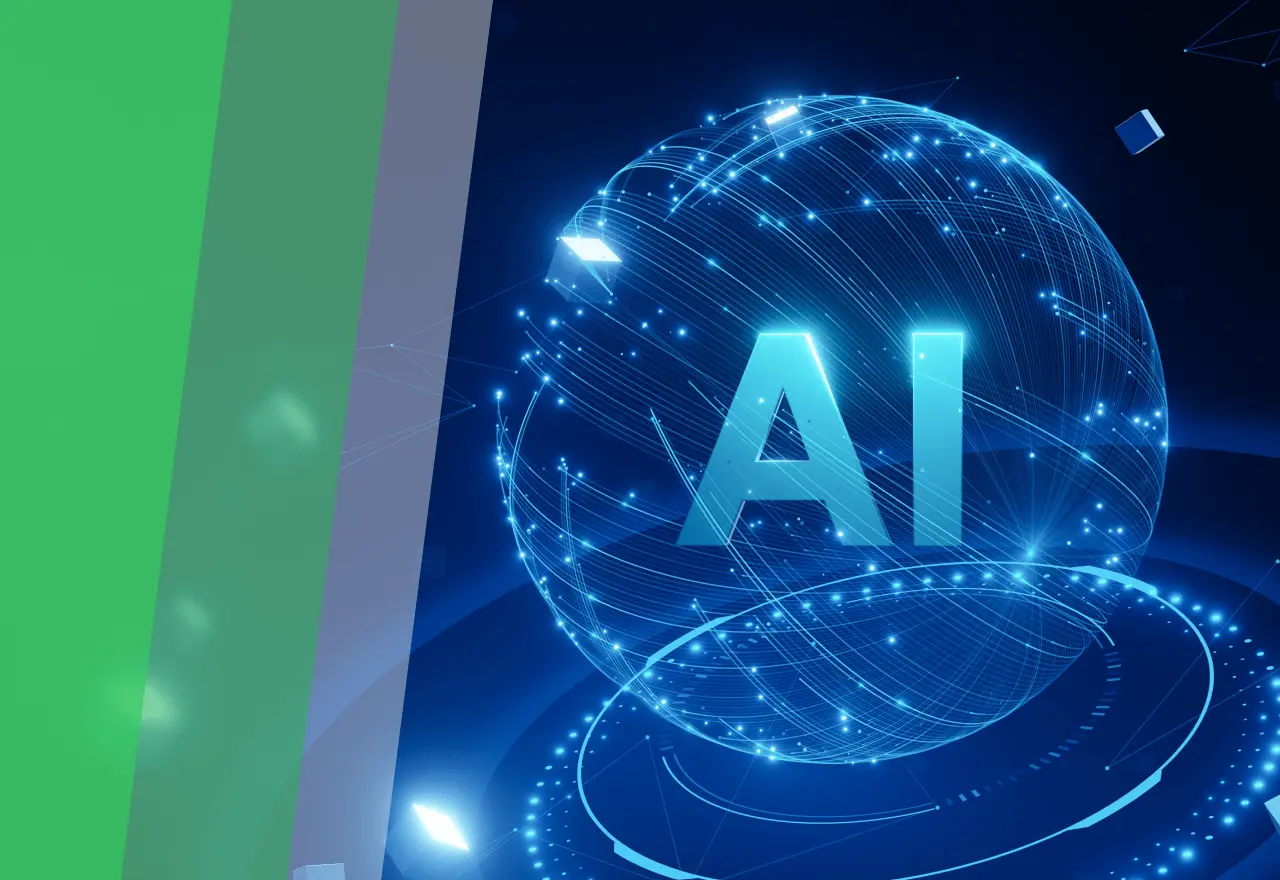How Much Does It Cost to Develop an AI App in 2025?
Table of contents
- AI App Development Cost Breakdown
- Development time
- AI model complexity
- Data acquisition & preparation
- AI frameworks & libraries
- Cloud computing & infrastructure
- API integration
- UX/UI design
- Security & compliance
- Testing & quality assurance
- Maintenance & support
- Deployment & hosting
- Pricing Models for AI App Development
- Fixed-price model
- Time and materials (T&M) model
- Dedicated team model
- Value-based pricing
- Hybrid models
- For large businesses:
- For small and medium-sized businesses:
- For startups:
- Examples of Estimating AI App Development Costs
- Simple AI chatbot
- AI-powered recommendation system
- Advanced AI assistant
- Deep learning app for image recognition
- AI agents for automating business processes
- AI assistants for personalized learning
- AI for data tasks
- Cleaning and preparing data automatically
- Analyzing data and finding patterns
- Predictice AI
- Choosing the Right Development Partner for Your AI Project
- Experience and expertise
- Portfolio and case studies
- Communication and collaboration
- Quality assurance
- Innovation and adaptability
- Client references
- US market experience
- Choosing Emerline as your AI partner
- Conclusion
Developing an AI-powered application typically costs between $50,000 and upwards of $500,000. This highly variable price range depends significantly on the app's complexity and feature set. Basic AI functionalities are more budget-friendly, while sophisticated machine learning and deep learning integrations will increase the investment required.
But is investing in AI development worth it? Consider this: the global artificial intelligence market, valued at 243.72 billion in 2025 USD, is projected to explode to around 826.73 billion USD by 2030, representing a solid CAGR of 27.67% from 2025 to 2030. This staggering growth underscores the potential and the importance of embracing AI solutions.

AI App Development Cost Breakdown
Artificial intelligence is no longer a futuristic concept—it's a present-day reality that is rapidly reshaping the technological landscape and fundamentally altering how we interact with the digital world. From simple voice-activated assistants to sophisticated personalized recommendation systems, AI-powered applications are becoming increasingly woven into the fabric of our daily lives.
If you're considering venturing into the world of AI app development, a critical question likely comes to mind: "What investment is required to bring my AI-powered vision to life?"
This guide will provide a comprehensive breakdown of the key factors influencing the cost of AI integration and development. We'll explore various pricing models commonly used in the industry and offer valuable insights into established benchmarks, empowering you to make informed decisions about your budget and expectations as you embark on your AI app development journey.
Before discussing the specifics of AI app development costs, it's essential to understand the components that contribute to the overall price tag. Various key components impact the price of developing an AI-based application.

The following table outlines the costs associated with AI app development.
| Aspect | Description | Price Range | Notes |
| Development Time | Time spent by developers designing, developing, and testing the AI application. | $80–$250+ per hour | Rates vary significantly based on location (e.g., Silicon Valley vs. other regions), developer experience, and whether you're working with freelancers, an agency, or in-house developers. |
| AI Model Complexity | The complexity of the AI algorithms and models used in the application. | Highly variable |
Simple AI (e.g., rule-based systems) will be less expensive than complex machine learning or deep learning models. Consider factors like the type of data, desired accuracy, and need for explainability. |
| Data Acquisition & Preparation | Gathering, cleaning, labeling, and preparing data for training AI models. | $5,000–$50,000+ | This can be a significant cost driver. Consider data sources, volume, quality, and the need for manual annotation. |
| AI Frameworks & Libraries | Utilizing open-source or commercial AI frameworks and libraries (e.g., TensorFlow, PyTorch, scikit-learn). | Mostly free, some enterprise options may cost $10,000+ per year | Most popular frameworks are open-source, but enterprise versions with support and advanced features can be costly. |
| Cloud Computing & Infrastructure | Costs for cloud platforms (AWS, Azure, GCP) for training, deploying, and running AI models. | $1,000–$100,000+ per month | Costs depend on usage, storage, compute instances, and chosen services. Consider serverless options and optimization strategies. |
| API Integration | Integrating third-party AI APIs for functionalities like natural language processing, computer vision, etc. (e.g., Google Cloud AI, Amazon Rekognition). | $0.001–$10.00+ per API call | Pricing varies greatly by provider and usage volume. Factor in API call limits and potential overage charges. |
| UX/UI Design | Designing user interfaces and experiences for AI apps. | $5,000–$50,000+ | Crucial for user adoption. Costs depend on complexity, number of screens, and design iterations. |
| Security & Compliance | Implementing security measures and ensuring compliance with regulations (e.g., GDPR, CCPA). | $10,000–$100,000+ | Essential for protecting user data and building trust. Costs vary based on the sensitivity of data and regulatory requirements. |
| Testing & Quality Assurance | Thoroughly testing the AI app for functionality, performance, and security. | 20% - 30% of development cost | Includes unit testing, integration testing, and user acceptance testing. |
| Maintenance & Support |
Ongoing maintenance, updates, bug fixes, and support for the AI application. | 15% - 25% of initial development cost per year | Includes monitoring, performance optimization, and addressing user feedback. |
| Deployment & Hosting |
Costs associated with deploying and hosting the AI application (e.g., web servers, app stores). | $100–$10,000+ per month | Varies based on hosting provider, traffic volume, and infrastructure needs. |
Various key components impact the price of developing an AI-based application.
Development time
This is the most significant cost driver for most AI projects. It encompasses the time your development team spends on every stage of the process, from initial design and conceptualization to coding, testing, and refinement. Factors influencing development time include the complexity of the AI features, the chosen technology stack, the developers' experience, and the level of project management involved. Remember that unexpected challenges and iterations can extend the timeline, so building in buffer time and having a flexible approach is crucial.
AI model complexity
The complexity of the AI model you choose directly impacts cost. Simple rule-based systems or basic machine learning algorithms will generally be quicker and less expensive to implement than sophisticated deep learning models. Consider the type of data you're working with, the desired accuracy level, and whether you need the model to be explainable (i.e., able to provide insights into its decision-making process). More complex models often require more data, processing power, and specialized expertise, contributing to higher costs.
Data acquisition & preparation
High-quality data is the foundation of any successful AI application. This aspect covers the costs of acquiring, cleaning, labeling, and preparing data for training your AI models. Depending on your project, you might need to purchase datasets, collect data from various sources, or hire human annotators to label data. Your data's volume, quality, and format will all influence the cost. Don't underestimate the importance of this stage, as poorly prepared data can lead to inaccurate or biased AI models.
AI frameworks & libraries
Thankfully, many powerful AI frameworks and libraries are available as open-source tools, which can significantly reduce costs. However, you might consider commercial options for enterprise-grade applications or those requiring specialized features and support. These can come with licensing or subscription fees, but they often offer benefits like dedicated support, advanced functionalities, and enhanced security.
Cloud computing & infrastructure
Cloud platforms like AWS, Azure, and GCP provide the infrastructure and services needed to train, deploy, and run AI models. Costs depend on your usage patterns, storage needs, the type of compute instances you choose, and the specific cloud services you utilize. Optimizing your cloud resources and exploring cost-effective options like serverless computing is essential to managing expenses.
API integration
If your AI app requires functionalities like natural language processing, computer vision, or speech recognition, you might leverage third-party AI APIs. These APIs offer pre-built AI models and services, saving development time and effort. However, they come with usage-based pricing, so it's crucial to understand the API's pricing structure, call limits, and potential overage charges.
UX/UI design
A user-friendly and intuitive interface is crucial for the success of any application, and AI apps are no exception. Investing in UX/UI design ensures that your app is easy to navigate, visually appealing, and provides a positive user experience. Costs here depend on the complexity of the design, the number of screens or interactions, and the number of design iterations required.
Security & compliance
Security is paramount, especially when dealing with sensitive user data. This aspect covers the costs of implementing robust security measures and encryption protocols and ensuring compliance with relevant data privacy regulations like GDPR and CCPA. The price will vary based on the sensitivity of the data your app handles and the specific regulatory requirements you need to meet.
Testing & quality assurance
Thorough testing is essential to ensure your AI app functions correctly, performs reliably, and is free of bugs and security vulnerabilities. This includes various types of testing, such as unit testing, integration testing, and user acceptance testing. Investing in quality assurance helps you deliver a polished and reliable product, minimizing the risk of costly issues down the line.
Maintenance & support
Once your AI app is launched, ongoing maintenance and support are crucial to keep it running smoothly, address user feedback, and adapt to evolving needs. This includes regular updates, bug fixes, performance optimization, and potentially retraining AI models with new data. It's important to factor in these ongoing costs to ensure the long-term success of your AI application.
Deployment & hosting
You must deploy your AI app and choose a hosting solution. This could involve web servers, cloud hosting, or even app store deployments. Costs vary based on your preferred hosting provider, the expected traffic volume, and application infrastructure requirements.
Pricing Models for AI App Development
Regarding pricing for AI app development, several models are commonly used by development agencies and companies. Each has its pros and cons, and the best choice depends on the specifics of your project. Here's a ballpark breakdown:
| Feature | Fixed-Price | Time & Materials (T&M) | Dedicated Team | Value-Based |
| Pricing Basis | Pre-defined project scope and cost | Hourly or daily rates for time and materials | Monthly retainer fee for a dedicated team | Value delivered to the client |
| Flexibility | Low | High | Medium | High (depending on value metrics) |
| Budget Predictability | High | Low | Medium | Medium (depends on value achievement) |
| Project Suitability | Well-defined projects with clear requirements | Projects with evolving scope or uncertain requirements | Large-scale, complex projects requiring ongoing development | Projects with measurable outcomes and clear value propositions |
| Client Control | Low | Medium | High | High (depending on value definition) |
| Risk | Higher risk for the development team if scope changes | Higher risk for the client if budget is not managed effectively | Shared risk between client and team | Shared risk, but strong emphasis on achieving value |
| Communication | Important, but less frequent | Frequent and detailed communication is crucial | Ongoing communication and collaboration | Regular communication and reporting on value metrics |
| Pros | Budget certainty, clear deliverables | Flexibility, adaptability to changing needs | Dedicated resources, focused expertise | Aligns incentives, focuses on outcomes |
| Cons | Less flexible, can be costly for changes | Budget uncertainty, requires close monitoring | Higher upfront cost, potential for underutilization | Requires careful value definition and measurement |
Fixed-price model
This model defines the project scope, timeline, and cost upfront, and the client agrees to a set price for the entire project. This model works well for projects with clearly defined requirements, minimal anticipated changes, and a well-established scope. It offers budget certainty but can be less flexible if changes are needed during development. In the US market, fixed-price contracts often require detailed specifications and may include clauses for handling change requests, which can impact the final price.
Time and materials (T&M) model
In a T&M arrangement, the client pays for the time and materials spent on the project, typically billed at an hourly or daily rate. This model offers greater flexibility and is suitable for projects where the scope may evolve during development. However, close monitoring and communication are required to manage costs effectively. In the US, T&M contracts typically outline hourly rates for different roles (e.g., developers, designers, project managers) and may include estimates for material costs. Clients should carefully track progress and hours billed to avoid budget overruns.
Dedicated team model
With this model, the client hires a dedicated team of AI developers, designers, and specialists who focus solely on their project. The client pays a monthly retainer fee based on the team's size and expertise. This approach suits large-scale, complex projects requiring ongoing development and support. In the US, dedicated team pricing varies based on the team's location (onshore, nearshore, or offshore), the team members' seniority, and the duration of the engagement. Clients should establish clear communication channels and performance metrics to ensure the dedicated team meets their needs.
Value-based pricing
This model focuses on the value the AI app delivers to the client's business rather than just the time and materials spent on development. The pricing is tied to specific outcomes or milestones, and the client pays based on the achieved value. This requires careful definition and measurement of the value metrics. While less common, it aligns incentives between the client and the development team.
Hybrid models
Some projects may use a combination of these pricing models. For instance, a fixed-price model could be used for the initial phase of development, followed by a T&M model for ongoing maintenance and support. Hybrid models can offer a balance between predictability and flexibility.
So what to choose? Our recommendations:
For large businesses:
- Dedicated team model: This is often the preferred choice for large businesses with complex, long-term AI projects. They have the resources to invest in a dedicated team and benefit from the focused expertise and consistent collaboration.
- Value-based pricing: For large businesses with well-defined objectives and measurable outcomes, value-based pricing can align incentives and ensure that the AI solution delivers tangible business value.
- Time & materials (T&M): Can be suitable for large-scale projects with evolving requirements but requires careful budget management and oversight.
For small and medium-sized businesses:
- Fixed-price model: Offers budget predictability and clear deliverables, which can attract SMBs with limited resources. However, they must ensure the project scope is well-defined upfront to avoid unexpected costs.
- Time & materials (T&M): This can be a good option for SMBs with some flexibility in their budget and a need for adaptability during development. Requires careful monitoring of time and costs.
For startups:
- Time & materials (T&M): Often the most suitable choice for startups due to its flexibility and ability to adapt to changing needs and limited budgets. T&M allows for iterative development and adjustments as the startup learns and grows.
- Fixed-price model: Can be considered for smaller, well-defined projects with a clear scope.
- Lean approach: Startups should prioritize a lean approach, focusing on building a Minimum Viable Product (MVP) first to validate their idea and minimize initial costs.
Examples of Estimating AI App Development Costs
To get a better understanding of how much it costs to build an AI app, let's look at some examples of what you might want to create:
The estimated cost of building AI apps usually ranges from $50,000 and can go over $300,000 for native apps (Android and iOS). If you only need basic AI stuff, it could be around $50,000. But if you want advanced AI that can learn, it can cost more than $300,000. Don't forget that there are extra costs like getting the data ready, connecting things, and keeping it running.
Examples of AI app development costs in the US:
Simple AI chatbot
Price range: ($5,000 - $15,000)
Making a chatbot with AI that can give set answers and understand some of what you say can cost from $5,000 to $15,000. The price increases if you want it to be more personalized, understand more complicated stuff, or work with other systems.
Example: A small business might want a simple chatbot for its website that can answer common questions and direct visitors to the right place.
AI-powered recommendation system
Price range: $20,000 - $50,000
If you want to add AI to your online store or streaming service to suggest things people might like, it could cost between $20,000 and $50,000. The cost depends on how complex the AI is, how much information it needs to look at, and how personalized you want it to be.
Example: An online store could use AI to suggest products based on what someone has looked at before, what they've bought, and what other people like them have bought.
Advanced AI assistant
Price range: $50,000 - $100,000+
Building a brilliant AI assistant that can understand what you say, give personalized suggestions, and work with other apps can cost $50,000 to over $100,000. The final cost depends on how much it can do, how well it understands the language, and how many other apps it can use.
Example: A doctor's office might want a virtual assistant to schedule appointments, manage patient records, and help doctors make decisions.
Deep learning app for image recognition
Price range: $100,000 - $500,000+
If you need an app that uses deep learning to recognize images, find objects, or predict things, it could cost $100,000 to over $500,000. It all depends on how complicated the project is and how skilled the people who build it are.
Example: An insurance company might use an app that can analyze pictures of car accidents and estimate the cost of fixing the cars.
AI agents for automating business processes
Pricec range: $20,000 - $100,000+
AI agents can take over tedious tasks like entering data, answering emails, and scheduling meetings. How much it costs to build one depends on how complicated the tasks are and how well it needs to work with your existing systems.
Example: A sales team might use an AI agent to find potential customers, send them personalized emails, and set up meetings.
AI assistants for personalized learning
Price range: $30,000 - $150,000+
AI assistants can help people learn by giving them lessons tailored just for them, tracking their progress, and suggesting ways to improve. The cost depends on the amount of learning material, how personalized the AI needs to be, and how interactive it is.
Example: An online course might use an AI assistant to change the lessons based on how well each student is doing, suggest extra resources, and give feedback on assignments.
AI for data tasks
Price range: $10,000 - $200,000+
AI-powered solutions can streamline data-related tasks such as data entry, processing, analysis, and visualization. These tools can automate repetitive workflows, detect patterns, and generate insights to support decision-making. The cost varies based on factors like the complexity of data processing, integration with existing systems, and the level of AI-driven automation required.
Example: A financial company might use AI to automatically categorize transactions, detect anomalies, and generate reports, reducing manual work and improving accuracy in economic analysis.
Cleaning and preparing data automatically
Price range: $10,000 - $50,000
AI can find and fix mistakes in data, fill in missing information, and get the data ready to use.
Example: A bank might use AI to clean up and get transaction data ready for analysis.
Analyzing data and finding patterns
Price range: $20,000 - $100,000
AI can discover hidden patterns in data that can help people make better decisions.
Example: A marketing team might use AI to look at customer data and figure out the best ways to advertise to people.
Predictice AI
Price range: $30,000 - $200,000
AI can use past data to predict what might happen in the future.
Example: A delivery company might use AI to predict the number of orders it will receive and plan the best delivery routes.
It's important to remember that the cost ranges provided are estimates. The actual cost of your AI app development project will ultimately depend on your vision's specific features, complexity, and scope. A detailed consultation with an experienced AI development team is essential for an accurate assessment and a tailored project plan that aligns with your budget and goals.
Read more: Assistive AI vs Agentic AI: Understanding the Future of Intelligent Automation
Choosing the Right Development Partner for Your AI Project
Embarking on custom AI development requires careful consideration when selecting a partner. The right partner can transform your vision into reality, while the wrong one can lead to cost overruns, delays, and a final product that doesn't meet your needs. Here's what Emerline recommends considering when choosing a development company for your AI application in the US market:
Experience and expertise
Look for a development company with a proven track record in AI application development. They should demonstrate expertise in the specific AI technologies and platforms relevant to your project, such as machine learning frameworks (TensorFlow, PyTorch), cloud computing platforms (AWS, Azure, GCP), and programming languages (Python, Java). Emerline's portfolio includes successful AI implementations across various industries, showcasing our diverse skillset and ability to deliver results.
Portfolio and case studies
Review the company's portfolio and case studies to see examples of their previous work. Look for projects similar to yours regarding complexity, industry, and AI capabilities. Pay attention to the results they achieve for their clients. Emerline's case studies provide detailed insights into our development process, challenges faced, and successful outcomes, demonstrating our commitment to quality and client satisfaction.
Communication and collaboration
Effective communication is essential for a successful development partnership. Choose a company that prioritizes clear and consistent communication, provides regular project updates, and is responsive to your questions and concerns. Emerline emphasizes collaborative partnerships, ensuring our clients are actively involved throughout the development lifecycle, from initial consultation to final deployment and maintenance.
Quality assurance
Quality is paramount in AI development. Look for a company with a robust quality assurance process, including rigorous testing methodologies, code reviews, and performance optimization. Emerline adheres to strict quality assurance standards, ensuring that every AI solution we deliver is reliable and secure and performs as expected.
Innovation and adaptability
The field of AI is constantly evolving. Choose a partner that stays up-to-date with the latest advancements in AI and can adapt to new technologies and trends. Emerline fosters a culture of innovation, continuously exploring new AI approaches and integrating cutting-edge technologies into our solutions.
Client references
Don't hesitate to ask for client references. Speaking with previous clients can provide valuable insights into the company's work ethic, communication style, and ability to deliver on its promises.
US market experience
For businesses operating in the US, it's beneficial to partner with a company that has experience working with US clients and understands the specific market dynamics, regulations, and compliance requirements. Emerline has a strong presence in the US market, serving clients across various sectors and adhering to US industry standards.
Choosing Emerline as your AI partner
Emerline offers a comprehensive suite of AI development services, from initial ideation and consulting to custom development, integration, and ongoing support. Our team of experienced AI specialists is dedicated to helping businesses leverage the power of AI to achieve their goals. Contact us today to discuss your AI project and discover how Emerline can turn your vision into a successful reality.
Conclusion
Developing AI applications involves numerous factors that can influence the overall cost. By understanding these factors, exploring different pricing models, and – most importantly – choosing the right development partner, you can effectively budget for your AI project and make informed decisions that drive success. Emerline stands ready to be that partner, guiding you through every step of the process.
Published on Mar 25, 2025





